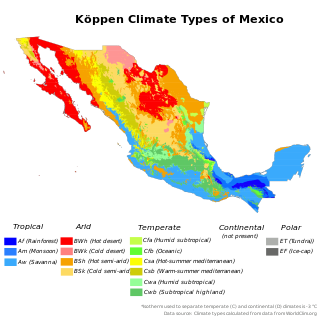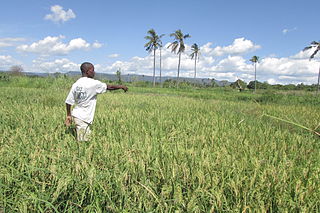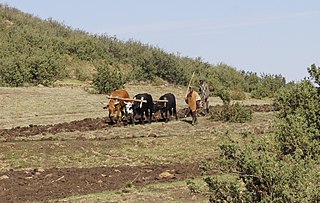
Environmental degradation is the deterioration of the environment through depletion of resources such as quality of air, water and soil; the destruction of ecosystems; habitat destruction; the extinction of wildlife; and pollution. It is defined as any change or disturbance to the environment perceived to be deleterious or undesirable. Environmental degradation process amplify the impact of environmental issues leave lasting impacts on the environment.

A landrace is a domesticated, locally adapted, often traditional variety of a species of animal or plant that has developed over time, through adaptation to its natural and cultural environment of agriculture and pastoralism, and due to isolation from other populations of the species. Landraces are distinct from cultivars and from standard breeds.

Agricultural biodiversity or agrobiodiversity is a subset of general biodiversity pertaining to agriculture. It can be defined as "the variety and variability of animals, plants and micro-organisms at the genetic, species and ecosystem levels that sustain the ecosystem structures, functions and processes in and around production systems, and that provide food and non-food agricultural products.” It is managed by farmers, pastoralists, fishers and forest dwellers, agrobiodiversity provides stability, adaptability and resilience and constitutes a key element of the livelihood strategies of rural communities throughout the world. Agrobiodiversity is central to sustainable food systems and sustainable diets. The use of agricultural biodiversity can contribute to food security, nutrition security, and livelihood security, and it is critical for climate adaptation and climate mitigation.

Agroforestry is a land use management system in which combinations of trees are grown around or among crops or pasture. Agroforestry combines agricultural and forestry technologies to create more diverse, productive, profitable, healthy, and sustainable land-use systems. Benefits include increasing farm profitability, reduced soil erosion, creating wildlife habitat, managing animal waste, increased biodiversity, improved soil structure, and carbon sequestration.

A smallholding or smallholder is a small farm operating under a small-scale agriculture model. Definitions vary widely for what constitutes a smallholder or small-scale farm, including factors such as size, food production technique or technology, involvement of family in labor and economic impact. Smallholdings are usually farms supporting a single family with a mixture of cash crops and subsistence farming. As a country becomes more affluent, smallholdings may not be self-sufficient, but may be valued for the rural lifestyle. As the sustainable food and local food movements grow in affluent countries, some of these smallholdings are gaining increased economic viability. There are an estimated 500 million smallholder farms in developing countries of the world alone, supporting almost two billion people.
Food biodiversity is defined as "the diversity of plants, animals and other organisms used for food, covering the genetic resources within species, between species and provided by ecosystems."

Shade-grown coffee is a form of the crop produced from coffee plants grown under a canopy of trees. A canopy of assorted types of shade trees is created to cultivate shade-grown coffee. Because it incorporates principles of natural ecology to promote natural ecological relationships, shade-grown coffee can be considered an offshoot of agricultural permaculture or agroforestry. The resulting coffee can be marketed as "shade-grown".

The climate of Mexico is very diverse. The Tropic of Cancer effectively divides the country into temperate and tropical zones. Land that is north of the twenty-fourth parallel experiences lower temperatures during the winter months. South of the twenty-fourth parallel, temperatures are fairly consistent all year round and vary solely as a function of elevation. The north of the country usually receives less precipitation than the south.

Agroecology is an applied science that involves the adaptation of ecological concepts to the structure, performance, and management of sustainable agroecosystems. In Latin America, agroecological practices have a long history and vary between regions but share three main approaches or levels: plot scale, farm scale, and food system scale. Agroecology in Latin American countries can be used as a tool for providing both ecological, economic, and social benefits to the communities that practice it, as well as maintaining high biodiversity and providing refuges for flora and fauna in these countries. Due to its broad scope and versatility, it is often referred to as "a science, a movement, a practice."
Crop diversity or crop biodiversity is the variety and variability of crops, plants used in agriculture, including their genetic and phenotypic characteristics. It is a subset of a specific element of agricultural biodiversity. Over the past 50 years, there has been a major decline in two components of crop diversity; genetic diversity within each crop and the number of species commonly grown.

Climate change is an important issue in Sri Lanka, and its effects threaten to impact both human and natural systems. Roughly 50 percent of its 22 million citizens live in low-lying coastal areas in the west, south, and south-west of the island, and are at risk of future sea level rise. Climate change also threatens the island's biodiversity, including its marine ecosystem and coastal coral reef environments. Sea-level rise due to climate change has the potential to affect the overall abundance of endemic species. Sri Lanka's coastal regions, such as the Northern Province and the Northern Western Province, are considered major hotspots and extremely vulnerable to climate change. These maritime provinces are the most densely populated. In addition to being a threat to Sri Lanka's biodiversity, climate change may cause disastrous consequences on various levels in such areas. Such consequences include: Affecting agricultural productivity, causing natural disasters like floods and droughts, increasing the spread of infectious illnesses, and finally undermining the living standards.

Climate change in Africa is an increasingly serious threat as Africa is among the most vulnerable continents to the effects of climate change. Some sources even classify Africa as "the most vulnerable continent on Earth". Climate change and climate variability will negatively impact agricultural production, food security, water security and ecosystem services. As a result, there will be severe consequences on lives and sustainable development in Africa.
The effects of climate change in Saskatchewan are now being observed in parts of the province. There is evidence of reduction of biomass in Saskatchewan's boreal forests that is linked by researchers to drought-related water stress stemming from global warming, most likely caused by greenhouse gas emissions. While studies, as early as 1988 have shown that climate change will affect agriculture, whether the effects can be mitigated through adaptations of cultivars, or crops, is less clear. Resiliency of ecosystems may decline with large changes in temperature. The provincial government has responded to the threat of climate change by introducing a plan to reduce carbon emissions, "The Saskatchewan Energy and Climate Change Plan", in June 2007.

There are numerous effects of climate change on agriculture, many of which are making it harder for agricultural activities to provide global food security. Rising temperatures and changing weather patterns often result in lower crop yields due to water scarcity caused by drought, heat waves and flooding. These effects of climate change can also increase the currently-rare risk of several regions suffering simultaneous crop failures, which would have significant consequences for the global food supply. Many pests and plant diseases are also expected to either become more prevalent or to spread to new regions. The world's livestock are also expected to be affected by many of the same issues, from greater heat stress to animal feed shortfalls and the spread of parasites and vector-borne diseases.

Climate change in Tanzania is affecting the natural environment and residents of Tanzania. Temperatures in Tanzania are rising with a higher likelihood of intense rainfall events and of dry spells.
Climate change and agriculture are complexly related processes. In the United States, agriculture is the second largest emitter of greenhouse gases (GHG), behind the energy sector. Direct GHG emissions from the agricultural sector account for 8.4% of total U.S. emissions, but the loss of soil organic carbon through soil erosion indirectly contributes to emissions as well. While agriculture plays a role in propelling climate change, it is also affected by the direct and secondary consequences of climate change. USDA research indicates that these climatic changes will lead to a decline in yield and nutrient density in key crops, as well as decreased livestock productivity. Climate change poses unprecedented challenges to U.S. agriculture due to the sensitivity of agricultural productivity and costs to changing climate conditions. Rural communities dependent on agriculture are particularly vulnerable to climate change threats.
Climate change impacts are occurring in Zimbabwe, even though the country's contribution to greenhouse gas emissions is very minimal.

Climate change is the consequence of long-term alterations in the Earth's climate caused by the emission of greenhouse gases such as carbon dioxide (CO2) and methane (CH4). These gases can trap heat in the atmosphere, resulting in global warming and a heightened temperature on our planet. The activities carried out by humans, such as the utilization of fossil fuels, along with large-scale commercial agriculture and deforestation, are accountable for the release of these greenhouse gases. The escalating temperatures and escalating extreme heat conditions, uncertain and progressively unpredictable precipitation, and extreme weather provoke new challenges and exacerbate existing ones.

Lesotho is a country in southern Africa that is already experiencing the negative effects of climate change, including increased frequency of extreme weather, such as droughts, increased rates of soil erosion and desertification, and reduced soil fertility. Lesotho is a landlocked country that is particularly vulnerable to the negative impacts of climate variability and changes in water and food security, as well as adverse conditions to health, human settlements, and the energy sector.
Climate change effects on tropical regions includes changes in marine ecosystems, human livelihoods, biodiversity, degradation of tropical rainforests and effects the environmental stability in these areas. Climate change is characterized by alterations in temperature, precipitation patterns, and extreme weather events. Tropical areas, located between the Tropic of Cancer and the Tropic of Capricorn, are known for their warm temperatures, high biodiversity, and distinct ecosystems, including rainforests, coral reefs, and mangroves.






















